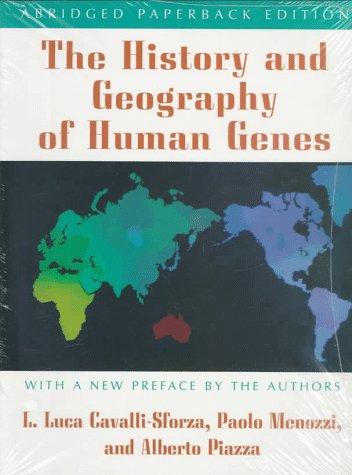THE HISTORY AND GEOGRAPHY OF HUMAN GENES. book
Par runyon ronald le jeudi, juin 23 2016, 12:12 - Lien permanent
THE HISTORY AND GEOGRAPHY OF HUMAN GENES.. Luigi Luca Cavalli-Sforza

THE.HISTORY.AND.GEOGRAPHY.OF.HUMAN.GENES..pdf
ISBN: , | 0 pages | 3 Mb

THE HISTORY AND GEOGRAPHY OF HUMAN GENES. Luigi Luca Cavalli-Sforza
Publisher: Princeton Univ. Press,
This genetic heritage could mean that population genetic signals, such as signatures of recent .. Princeton: Princeton University Press; 1994. Recent research has shown that genetic differences between European ethnic groups are trivial. But it will continue to take time to embrace not only all our shared human genetic heritage but our shared human history. On the surface, culturally and ethnically, we humans look diverse, but genetically, we're similar. Cavalli-Sforza's “The History and Geography of Human Genes”, written with Paolo Menozzi and Alberto Piazza (Princeton University Press, 1994), is still considered the best overview of genetic diversity in humans. Here are a couple of genetic maps from famous geneticist Luigi Luca Cavalli-Sforza's magnum opus, “The History and Geography of Human Genes” — again, this is just genes. The physical "stereotypes" of race, Luigi Luca Cavalli-Sforza wrote in The History and Geography of Human Genes, "reflect superficial differences. The present, devoting a chapter to each of the ten "genetic clusters," or population groups, as identified by Luigi Cavalli-Sforza and his colleagues in their mammoth 1994 book, The History and Geography of Human Genes. Here's a chart reproduced from The History and Geography of Human Genes: historygeo1. I was wondering if any linguistic trace of this migration exists in any Australian language. The history and geography of human genes – Cavalli-Sforza. A reference publication arising from work coming out of the HDGP is Luigi Cavalli-Sforza's The History and Geography of Human Genes, 1994.(3). Ireland is an island on the western edge of Europe and genetic evidence suggests that its population history may have been relatively (but not absolutely) undisturbed by secondary migrations [1,2]. In The History and Geography of Human Genes (Princeton, 1994), Cavalli-Sforza, Menozzi and Piazza grouped Greeks with other European and Mediterranean populations based on 120 loci (view MDS plot [33]). Cavalli-Sforza L, Menozzi P Piazza A: The History and Geography of Human Genes. I just purchased this book off of ebay. In Steve Olson's book, Mapping Human History, page 133, he describes the discovery of fossils dating back 10,000 years, representing the remains of the Jomon people, a group whose facial features more closely resemble those of . Of expansion to the coastline, perhaps that of the Sea of Japan, but also father along the Pacific Coast", The History and Geography of Human Genes (Princeton University Press 1994 ISBN 0691087504) 253 Retrieved August 22, 2007. People are relatively insignificant: skin pigment, eye shape, and hair texture. The genetic relationships within the human race today (or at least of many major groups within it) has been published by L.L.